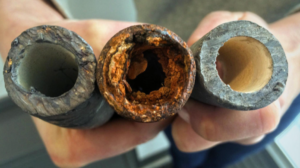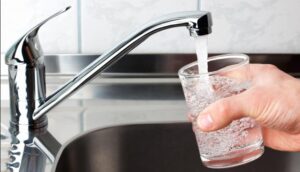Tap Water Quality Concerns in America
When most of us turn on our faucets to get water for drinking, bathing, and cleaning, we take it for granted that this liquid is safe.
However, recent reports from the Department of Civil and Environmental Engineering at the University of Iowa and J.D. Power are expressing concern about water quality in some parts of the United States.
It turns out that water central systems in many states have pipes over fifty years old, and some systems have one hundred or more years old subsystems. Lurking inside these networks are hundreds of potential contaminants, including lead.
Harmful Effects of Lead
Lead is a neurotoxin, meaning it causes harm to the functioning of the nervous system. If ingested, lead can damage organs, interfere with the body’s normal processes, and lead to brain development problems, among other health hazards.
Replacing Old Pipes

The job is often incomplete when infrastructure improvement projects are done to bring water mains up to date. The water experts explain that this kind of partial fix leaves one set of pipes to exist alongside the new pipes.
Adding insult to injury is when city officials think that chemical treatments can resolve the issue of contaminated water. There is money needed to replace old pipes with copper or at least remove them altogether, but governments are often hesitant to allocate the budget for old lead pipes that have been in the ground for years.
Yanna Lambrinidou, a medical anthropologist from Virginia Tech University, states that this is an “immoral” action.
States with Poor Water Quality
J.D. Power looked at customer feedback regarding quality, reliability, and other criteria to determine the worst states for tap water quality. The states that ranked worst were Indiana (10th worst), Arizona (9th), Mississippi (8th), Ohio (7th), Pennsylvania (6th), Texas (5th), New Mexico (4th), Oklahoma (3rd), Maryland (2nd), and – Alabama (1st worst).
Testing and Filtering Water
If you want to ensure that the water from your faucets is safe to drink, then you might consider asking your local health department for a free water testing kit. If that’s impossible, they can test it at your home.
Once the test results are back, it’ll be wise to invest in a water filter. These are readily found on the market. According to the experts, the best lenders can remove bacteria, viruses, volatile organic chemicals, pharmaceuticals, pesticides, herbicides, heavy metals, and lead.
Extra Tips for Cleaner Water
Other additional strategies for ensuring cleaner tap water are to let the cold water run for a couple of minutes before filling up a glass to drink and always use cold water for drinking and cooking since hot water can cause contaminants to dissolve.
Since dirty pipes can negatively affect both water pressure and quality, it’s wise to replace galvanized plumbing with copper pipes when possible. You should also clean faucet aerators regularly and replace them if needed.
Finally, for better tap water quality, drain your water heater annually. The tank of your water heater can be a home for bacteria, metals, and sediment, and clearing it out regularly is an excellent way to protect your home’s water quality.
The Bottom Line
As you can see, many steps can be taken to ensure your home’s tap water is safe for drinking, bathing, and cleaning. And, since clean water tastes better, you’ll be more likely to drink more of it, which keeps you hydrated.
But it all begins with knowing where your water comes from and whether or not it’s been contaminated. This means having your water tested and then filtering the water when needed. Follow those steps and enjoy clean, delicious tap water in your home.



